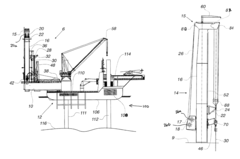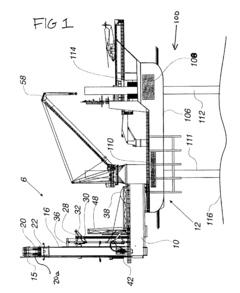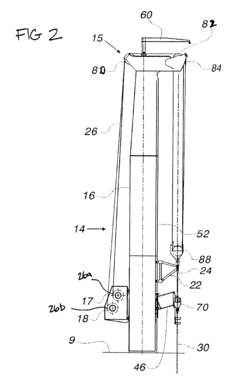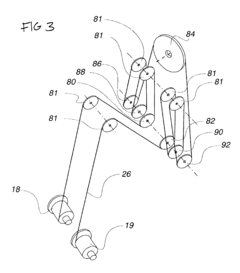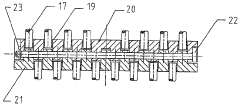Innovative Kevlar Applications in Oil and Gas Drilling
JUL 10, 202510 MIN READ
Generate Your Research Report Instantly with AI Agent
Patsnap Eureka helps you evaluate technical feasibility & market potential.
Kevlar in O&G Drilling: Background and Objectives
Kevlar, a high-strength synthetic fiber developed by DuPont in the 1960s, has revolutionized numerous industries with its exceptional properties. In the oil and gas drilling sector, Kevlar's potential applications have garnered significant attention due to its unique combination of strength, lightweight nature, and resistance to harsh environments.
The evolution of Kevlar in oil and gas drilling can be traced back to the early 1990s when the industry began exploring alternatives to traditional materials used in drilling operations. As drilling activities expanded into more challenging environments, such as deep-water and high-pressure high-temperature (HPHT) wells, the need for advanced materials became increasingly apparent.
Initially, Kevlar found its way into the industry through reinforcement applications in drilling hoses and umbilicals. These early adoptions demonstrated the material's ability to enhance the durability and performance of critical drilling components while reducing overall weight. This success paved the way for further exploration of Kevlar's potential in various aspects of drilling operations.
The primary objective of incorporating Kevlar into oil and gas drilling is to address several key challenges faced by the industry. These include improving the strength-to-weight ratio of drilling equipment, enhancing the reliability of downhole tools, and extending the operational life of drilling components in extreme conditions. By leveraging Kevlar's unique properties, the industry aims to push the boundaries of drilling capabilities, enabling access to previously unreachable reserves and improving overall operational efficiency.
As the oil and gas sector continues to evolve, the role of advanced materials like Kevlar becomes increasingly crucial. The industry is constantly seeking ways to optimize drilling processes, reduce costs, and minimize environmental impact. Kevlar's potential to contribute to these goals has driven ongoing research and development efforts to identify innovative applications within the drilling sector.
The current technological landscape surrounding Kevlar in oil and gas drilling is characterized by a blend of established applications and emerging innovations. While some Kevlar-based solutions have already been successfully implemented in the field, there remains significant potential for further advancements. Researchers and engineers are actively exploring novel ways to integrate Kevlar into drilling systems, tools, and equipment to address persistent challenges and unlock new possibilities in oil and gas exploration and production.
As we delve deeper into the applications of Kevlar in oil and gas drilling, it is essential to consider the broader context of the industry's technological evolution. The integration of advanced materials like Kevlar represents a critical step towards developing more resilient, efficient, and sustainable drilling practices. This ongoing transformation is expected to play a pivotal role in shaping the future of energy exploration and extraction.
The evolution of Kevlar in oil and gas drilling can be traced back to the early 1990s when the industry began exploring alternatives to traditional materials used in drilling operations. As drilling activities expanded into more challenging environments, such as deep-water and high-pressure high-temperature (HPHT) wells, the need for advanced materials became increasingly apparent.
Initially, Kevlar found its way into the industry through reinforcement applications in drilling hoses and umbilicals. These early adoptions demonstrated the material's ability to enhance the durability and performance of critical drilling components while reducing overall weight. This success paved the way for further exploration of Kevlar's potential in various aspects of drilling operations.
The primary objective of incorporating Kevlar into oil and gas drilling is to address several key challenges faced by the industry. These include improving the strength-to-weight ratio of drilling equipment, enhancing the reliability of downhole tools, and extending the operational life of drilling components in extreme conditions. By leveraging Kevlar's unique properties, the industry aims to push the boundaries of drilling capabilities, enabling access to previously unreachable reserves and improving overall operational efficiency.
As the oil and gas sector continues to evolve, the role of advanced materials like Kevlar becomes increasingly crucial. The industry is constantly seeking ways to optimize drilling processes, reduce costs, and minimize environmental impact. Kevlar's potential to contribute to these goals has driven ongoing research and development efforts to identify innovative applications within the drilling sector.
The current technological landscape surrounding Kevlar in oil and gas drilling is characterized by a blend of established applications and emerging innovations. While some Kevlar-based solutions have already been successfully implemented in the field, there remains significant potential for further advancements. Researchers and engineers are actively exploring novel ways to integrate Kevlar into drilling systems, tools, and equipment to address persistent challenges and unlock new possibilities in oil and gas exploration and production.
As we delve deeper into the applications of Kevlar in oil and gas drilling, it is essential to consider the broader context of the industry's technological evolution. The integration of advanced materials like Kevlar represents a critical step towards developing more resilient, efficient, and sustainable drilling practices. This ongoing transformation is expected to play a pivotal role in shaping the future of energy exploration and extraction.
Market Demand Analysis for Advanced Drilling Materials
The oil and gas drilling industry has witnessed a growing demand for advanced materials that can withstand extreme conditions and improve operational efficiency. Kevlar, a high-strength synthetic fiber traditionally used in bulletproof vests and aerospace applications, has emerged as a promising material for innovative applications in drilling operations. The market demand for Kevlar-based solutions in oil and gas drilling is driven by several factors that highlight the industry's need for more durable, lightweight, and high-performance materials.
One of the primary drivers for Kevlar applications in drilling is the increasing depth and complexity of oil and gas wells. As exploration moves into deeper waters and more challenging geological formations, traditional materials often fall short in terms of strength-to-weight ratio and resistance to harsh environments. Kevlar's exceptional tensile strength, which is five times stronger than steel on an equal-weight basis, makes it an attractive option for reinforcing drilling components and equipment.
The offshore drilling sector, in particular, has shown significant interest in Kevlar-based solutions. The material's corrosion resistance and ability to withstand high pressures make it ideal for use in risers, umbilicals, and other critical subsea equipment. Market analysis indicates that the offshore segment is expected to be a major contributor to the growth of advanced drilling materials, with Kevlar playing a crucial role in addressing the unique challenges of deepwater operations.
Another key factor driving market demand is the industry's focus on reducing operational costs and improving efficiency. Kevlar's lightweight nature can lead to significant weight savings in drilling equipment, resulting in lower transportation and handling costs. Additionally, the material's durability and resistance to wear and tear can extend the lifespan of drilling components, reducing maintenance frequency and associated downtime.
The push for environmentally friendly drilling practices has also contributed to the increased interest in Kevlar applications. The material's potential to reduce the environmental footprint of drilling operations, through lighter equipment and longer-lasting components, aligns with the industry's sustainability goals and regulatory requirements.
Market research suggests that the adoption of Kevlar in oil and gas drilling is still in its early stages, with significant growth potential. As awareness of its benefits spreads and more field-proven applications emerge, the demand for Kevlar-based solutions is expected to accelerate. This trend is further supported by ongoing research and development efforts aimed at optimizing Kevlar formulations specifically for drilling applications.
The market for advanced drilling materials, including Kevlar-based products, is characterized by a mix of established players and innovative startups. Major chemical companies and material science firms are investing in developing specialized Kevlar composites tailored for the oil and gas sector, while smaller companies are focusing on niche applications and custom solutions.
One of the primary drivers for Kevlar applications in drilling is the increasing depth and complexity of oil and gas wells. As exploration moves into deeper waters and more challenging geological formations, traditional materials often fall short in terms of strength-to-weight ratio and resistance to harsh environments. Kevlar's exceptional tensile strength, which is five times stronger than steel on an equal-weight basis, makes it an attractive option for reinforcing drilling components and equipment.
The offshore drilling sector, in particular, has shown significant interest in Kevlar-based solutions. The material's corrosion resistance and ability to withstand high pressures make it ideal for use in risers, umbilicals, and other critical subsea equipment. Market analysis indicates that the offshore segment is expected to be a major contributor to the growth of advanced drilling materials, with Kevlar playing a crucial role in addressing the unique challenges of deepwater operations.
Another key factor driving market demand is the industry's focus on reducing operational costs and improving efficiency. Kevlar's lightweight nature can lead to significant weight savings in drilling equipment, resulting in lower transportation and handling costs. Additionally, the material's durability and resistance to wear and tear can extend the lifespan of drilling components, reducing maintenance frequency and associated downtime.
The push for environmentally friendly drilling practices has also contributed to the increased interest in Kevlar applications. The material's potential to reduce the environmental footprint of drilling operations, through lighter equipment and longer-lasting components, aligns with the industry's sustainability goals and regulatory requirements.
Market research suggests that the adoption of Kevlar in oil and gas drilling is still in its early stages, with significant growth potential. As awareness of its benefits spreads and more field-proven applications emerge, the demand for Kevlar-based solutions is expected to accelerate. This trend is further supported by ongoing research and development efforts aimed at optimizing Kevlar formulations specifically for drilling applications.
The market for advanced drilling materials, including Kevlar-based products, is characterized by a mix of established players and innovative startups. Major chemical companies and material science firms are investing in developing specialized Kevlar composites tailored for the oil and gas sector, while smaller companies are focusing on niche applications and custom solutions.
Current Kevlar Applications and Challenges in Drilling
Kevlar, a high-strength synthetic fiber developed by DuPont, has found significant applications in the oil and gas drilling industry due to its exceptional properties. In drilling operations, Kevlar is primarily used in the manufacturing of drilling riser tensioner lines, umbilicals, and reinforced thermoplastic pipes (RTP). These applications leverage Kevlar's high tensile strength, low weight, and resistance to harsh environmental conditions.
Drilling riser tensioner lines made with Kevlar offer superior strength-to-weight ratios compared to traditional steel cables. This allows for deeper offshore drilling operations while reducing the overall weight of the drilling system. Kevlar-reinforced umbilicals provide enhanced durability and flexibility for subsea control systems, enabling more efficient communication and power transmission between surface vessels and subsea equipment.
Reinforced thermoplastic pipes incorporating Kevlar fibers exhibit improved pressure resistance and fatigue performance. These pipes are increasingly used in offshore flexible risers and flowlines, offering a lightweight alternative to steel pipes while maintaining high performance in demanding deepwater environments.
Despite its advantages, Kevlar faces several challenges in drilling applications. One primary concern is its susceptibility to UV degradation, which can compromise its long-term performance in surface applications. This necessitates additional protective measures or frequent replacement of exposed components. Another challenge is the relatively high cost of Kevlar compared to traditional materials, which can limit its widespread adoption in cost-sensitive drilling operations.
The abrasion resistance of Kevlar, while superior to many materials, still presents limitations in highly abrasive drilling environments. This can lead to premature wear in certain applications, particularly where continuous contact with abrasive drilling fluids or rock formations occurs. Additionally, the complex manufacturing processes required for Kevlar-reinforced components can pose challenges in terms of quality control and scalability.
Joining and termination of Kevlar-based materials in drilling equipment also present technical difficulties. Traditional welding or mechanical fastening methods used for steel components are not directly applicable to Kevlar, necessitating the development of specialized connection techniques. This can complicate repair and maintenance procedures in the field.
As the oil and gas industry continues to push the boundaries of drilling technology, addressing these challenges becomes crucial for expanding Kevlar's role in drilling operations. Ongoing research focuses on improving Kevlar's UV and abrasion resistance, developing cost-effective manufacturing processes, and enhancing joining technologies. These efforts aim to unlock the full potential of Kevlar in oil and gas drilling applications, enabling safer, more efficient, and environmentally friendly drilling operations in increasingly challenging environments.
Drilling riser tensioner lines made with Kevlar offer superior strength-to-weight ratios compared to traditional steel cables. This allows for deeper offshore drilling operations while reducing the overall weight of the drilling system. Kevlar-reinforced umbilicals provide enhanced durability and flexibility for subsea control systems, enabling more efficient communication and power transmission between surface vessels and subsea equipment.
Reinforced thermoplastic pipes incorporating Kevlar fibers exhibit improved pressure resistance and fatigue performance. These pipes are increasingly used in offshore flexible risers and flowlines, offering a lightweight alternative to steel pipes while maintaining high performance in demanding deepwater environments.
Despite its advantages, Kevlar faces several challenges in drilling applications. One primary concern is its susceptibility to UV degradation, which can compromise its long-term performance in surface applications. This necessitates additional protective measures or frequent replacement of exposed components. Another challenge is the relatively high cost of Kevlar compared to traditional materials, which can limit its widespread adoption in cost-sensitive drilling operations.
The abrasion resistance of Kevlar, while superior to many materials, still presents limitations in highly abrasive drilling environments. This can lead to premature wear in certain applications, particularly where continuous contact with abrasive drilling fluids or rock formations occurs. Additionally, the complex manufacturing processes required for Kevlar-reinforced components can pose challenges in terms of quality control and scalability.
Joining and termination of Kevlar-based materials in drilling equipment also present technical difficulties. Traditional welding or mechanical fastening methods used for steel components are not directly applicable to Kevlar, necessitating the development of specialized connection techniques. This can complicate repair and maintenance procedures in the field.
As the oil and gas industry continues to push the boundaries of drilling technology, addressing these challenges becomes crucial for expanding Kevlar's role in drilling operations. Ongoing research focuses on improving Kevlar's UV and abrasion resistance, developing cost-effective manufacturing processes, and enhancing joining technologies. These efforts aim to unlock the full potential of Kevlar in oil and gas drilling applications, enabling safer, more efficient, and environmentally friendly drilling operations in increasingly challenging environments.
Existing Kevlar-based Solutions for Drilling Operations
01 Kevlar-based protective materials
Kevlar is widely used in protective materials due to its high strength and lightweight properties. It is incorporated into various products such as bulletproof vests, helmets, and other personal protective equipment to enhance safety and durability.- Kevlar-reinforced composite materials: Kevlar fibers are used to reinforce various composite materials, enhancing their strength, durability, and impact resistance. These composites find applications in aerospace, automotive, and protective equipment industries.
- Kevlar in protective gear and clothing: Kevlar is utilized in the manufacture of protective gear and clothing, such as bulletproof vests, helmets, and cut-resistant gloves. Its high tensile strength and lightweight properties make it ideal for personal protection equipment.
- Kevlar-based fire-resistant materials: Kevlar is incorporated into fire-resistant materials and fabrics, providing enhanced thermal protection and flame retardancy. These materials are used in firefighting equipment, industrial safety gear, and high-temperature applications.
- Kevlar in automotive and aerospace applications: Kevlar is employed in various automotive and aerospace components to reduce weight while maintaining strength. It is used in tires, body panels, and structural parts to improve fuel efficiency and performance.
- Kevlar-enhanced sporting goods: Kevlar fibers are incorporated into sporting goods and equipment to improve performance and durability. Applications include tennis rackets, bicycle frames, and high-performance sails for competitive sailing.
02 Kevlar composites for aerospace applications
Kevlar is utilized in aerospace applications, often combined with other materials to create lightweight, high-strength composites. These composites are used in aircraft structures, spacecraft components, and satellite systems to reduce weight while maintaining structural integrity.Expand Specific Solutions03 Kevlar fibers in textile and clothing
Kevlar fibers are incorporated into textiles and clothing to enhance durability, cut resistance, and heat protection. Applications include protective workwear, sports equipment, and high-performance outdoor gear.Expand Specific Solutions04 Kevlar in automotive and transportation
Kevlar is used in automotive and transportation industries for reinforcing tires, brake pads, and other components. It enhances the strength and durability of these parts, improving vehicle performance and safety.Expand Specific Solutions05 Kevlar-reinforced construction materials
Kevlar is utilized to reinforce construction materials such as concrete, plastics, and composites. This application enhances the strength, durability, and crack resistance of structures, leading to improved longevity and performance in building and infrastructure projects.Expand Specific Solutions
Key Players in Kevlar and Drilling Technology
The innovative Kevlar applications in oil and gas drilling represent an emerging technology in the industry's maturation phase. The market for advanced drilling materials is expanding, driven by the need for more durable and efficient equipment in challenging environments. While the technology is still evolving, it shows promise in enhancing drilling performance and safety. Key players like Halliburton Energy Services, China National Petroleum Corp., and Saudi Arabian Oil Co. are likely investing in research and development to integrate Kevlar into their drilling operations. Smaller specialized firms and research institutions are also contributing to advancements in this field, indicating a competitive and dynamic landscape with potential for significant growth and innovation.
Halliburton Energy Services, Inc.
Technical Solution: Halliburton has pioneered the use of Kevlar in various drilling applications, particularly in the development of advanced drill strings and downhole tools. Their innovative approach includes the integration of Kevlar fibers into composite drill pipes, resulting in a significant reduction in weight while maintaining exceptional tensile strength[4]. This allows for longer horizontal reaches in directional drilling operations. Halliburton has also developed Kevlar-reinforced elastomers for use in downhole sealing elements, such as packers and bridge plugs, which offer improved durability and resistance to high-pressure, high-temperature environments[5]. Additionally, they have incorporated Kevlar into their hydraulic fracturing operations, using Kevlar-based proppants that offer enhanced conductivity and reduced flowback[6].
Strengths: Lightweight yet strong materials for extended-reach drilling, improved downhole tool performance, and enhanced fracturing efficiency. Weaknesses: Higher initial costs and potential challenges in recycling or disposing of Kevlar-composite materials.
Saudi Arabian Oil Co.
Technical Solution: Saudi Aramco has invested heavily in Kevlar-based technologies to enhance their drilling capabilities and operational efficiency. They have developed Kevlar-reinforced coiled tubing systems that offer increased tensile strength and fatigue resistance, allowing for extended reach in horizontal and multilateral wells[13]. This innovation has significantly improved the efficiency of well intervention and stimulation operations. Saudi Aramco has also implemented Kevlar-based composite risers for offshore drilling, which provide superior corrosion resistance and reduced weight compared to traditional steel risers[14]. Furthermore, they have introduced Kevlar-reinforced cement slurries that enhance wellbore integrity and zonal isolation in high-pressure, high-temperature wells[15].
Strengths: Extended reach capabilities in complex well geometries, improved corrosion resistance in offshore environments, and enhanced wellbore integrity. Weaknesses: Potential challenges in scaling up Kevlar-based technologies for large-scale operations and higher initial investment costs.
Core Innovations in Kevlar for Extreme Environments
Multipurpose unit for drilling and well intervention
PatentInactiveUS6932553B1
Innovation
- A multipurpose system featuring a pivotable and slidable cantilever with a modular tower, splittable block, hoist winch, and retractable trolley, allowing for efficient handling and storage of tubulars, and enabling the use of coiled tubulars with reduced operational costs and enhanced safety by minimizing hoist cable wear and optimizing winch design.
Device for drilling oil and gas wells
PatentWO2008123791A1
Innovation
- A drilling rig with a flexible endless working body, driven by a pulley system that utilizes centrifugal inertial forces for cutting rock, reducing the need for heavy equipment and allowing for directional drilling with adjustable cutting plates and a well flushing system, significantly reducing the weight and energy requirements of the drilling process.
Environmental Impact of Kevlar in Drilling Operations
The introduction of Kevlar in oil and gas drilling operations has significantly impacted the environmental landscape of the industry. Kevlar, a high-strength synthetic fiber, has been increasingly utilized in various drilling components due to its exceptional strength-to-weight ratio and durability. This innovative application has led to both positive and negative environmental consequences that warrant careful consideration.
One of the primary environmental benefits of using Kevlar in drilling operations is the reduction in overall material consumption. The superior strength of Kevlar allows for the production of lighter and more durable drilling equipment, which in turn reduces the amount of raw materials required for manufacturing. This decrease in material usage contributes to the conservation of natural resources and minimizes the environmental footprint associated with the production and transportation of drilling equipment.
Furthermore, the extended lifespan of Kevlar-reinforced drilling components has led to a reduction in waste generation. Traditional drilling equipment often requires frequent replacement due to wear and tear, resulting in substantial waste accumulation. Kevlar's resistance to abrasion and corrosion significantly extends the operational life of drilling tools, thereby reducing the frequency of replacements and the associated waste disposal issues.
However, the environmental impact of Kevlar in drilling operations is not entirely positive. The production process of Kevlar involves the use of harmful chemicals and energy-intensive manufacturing techniques. The synthesis of the polymer requires the use of sulfuric acid and other potentially hazardous substances, which can pose risks to the environment if not properly managed. Additionally, the energy consumption during Kevlar production contributes to greenhouse gas emissions, albeit indirectly.
Another environmental concern is the potential for Kevlar particles to be released into the environment during drilling operations. While Kevlar is generally considered chemically inert, the long-term effects of Kevlar microfibers on marine and terrestrial ecosystems are not yet fully understood. There is a need for further research to assess the potential bioaccumulation and impact of these particles on various organisms in the food chain.
The disposal of Kevlar-containing drilling equipment at the end of its lifecycle presents another environmental challenge. Unlike some traditional materials, Kevlar is not biodegradable and can persist in the environment for extended periods. Proper recycling and disposal methods for Kevlar-reinforced drilling components are crucial to mitigate potential long-term environmental impacts.
In conclusion, the environmental impact of Kevlar in drilling operations is multifaceted. While it offers significant benefits in terms of resource conservation and waste reduction, concerns regarding its production process, potential microfiber release, and end-of-life disposal necessitate ongoing research and the development of sustainable practices to maximize its environmental benefits while minimizing potential risks.
One of the primary environmental benefits of using Kevlar in drilling operations is the reduction in overall material consumption. The superior strength of Kevlar allows for the production of lighter and more durable drilling equipment, which in turn reduces the amount of raw materials required for manufacturing. This decrease in material usage contributes to the conservation of natural resources and minimizes the environmental footprint associated with the production and transportation of drilling equipment.
Furthermore, the extended lifespan of Kevlar-reinforced drilling components has led to a reduction in waste generation. Traditional drilling equipment often requires frequent replacement due to wear and tear, resulting in substantial waste accumulation. Kevlar's resistance to abrasion and corrosion significantly extends the operational life of drilling tools, thereby reducing the frequency of replacements and the associated waste disposal issues.
However, the environmental impact of Kevlar in drilling operations is not entirely positive. The production process of Kevlar involves the use of harmful chemicals and energy-intensive manufacturing techniques. The synthesis of the polymer requires the use of sulfuric acid and other potentially hazardous substances, which can pose risks to the environment if not properly managed. Additionally, the energy consumption during Kevlar production contributes to greenhouse gas emissions, albeit indirectly.
Another environmental concern is the potential for Kevlar particles to be released into the environment during drilling operations. While Kevlar is generally considered chemically inert, the long-term effects of Kevlar microfibers on marine and terrestrial ecosystems are not yet fully understood. There is a need for further research to assess the potential bioaccumulation and impact of these particles on various organisms in the food chain.
The disposal of Kevlar-containing drilling equipment at the end of its lifecycle presents another environmental challenge. Unlike some traditional materials, Kevlar is not biodegradable and can persist in the environment for extended periods. Proper recycling and disposal methods for Kevlar-reinforced drilling components are crucial to mitigate potential long-term environmental impacts.
In conclusion, the environmental impact of Kevlar in drilling operations is multifaceted. While it offers significant benefits in terms of resource conservation and waste reduction, concerns regarding its production process, potential microfiber release, and end-of-life disposal necessitate ongoing research and the development of sustainable practices to maximize its environmental benefits while minimizing potential risks.
Safety Regulations for Advanced Materials in O&G Sector
The oil and gas (O&G) industry's adoption of advanced materials like Kevlar necessitates a comprehensive framework of safety regulations. These regulations aim to ensure the safe use of innovative materials while maximizing their potential benefits in drilling operations.
Regulatory bodies, such as the Occupational Safety and Health Administration (OSHA) and the Bureau of Safety and Environmental Enforcement (BSEE), play crucial roles in establishing and enforcing safety standards for advanced materials in the O&G sector. These agencies work closely with industry stakeholders to develop guidelines that address the unique properties and potential risks associated with materials like Kevlar.
One key aspect of safety regulations for advanced materials is the requirement for thorough risk assessments. Companies must evaluate the potential hazards of using Kevlar-based products in drilling operations, considering factors such as chemical compatibility, temperature resistance, and mechanical properties under extreme conditions. These assessments help identify potential failure modes and inform the development of appropriate safety protocols.
Material certification and testing standards form another critical component of the regulatory framework. Manufacturers of Kevlar-based products for O&G applications must adhere to stringent quality control measures and provide comprehensive documentation of material properties and performance characteristics. This ensures that the materials meet the required safety and performance standards for use in challenging drilling environments.
Personal protective equipment (PPE) regulations have also been updated to incorporate advanced materials like Kevlar. Safety guidelines now specify the use of Kevlar-reinforced gloves, helmets, and protective clothing for workers in high-risk areas of drilling operations. These regulations aim to enhance worker safety by leveraging the superior strength and heat-resistant properties of Kevlar.
Environmental considerations are increasingly important in safety regulations for advanced materials in the O&G sector. Regulatory bodies require companies to assess the potential environmental impact of Kevlar-based products throughout their lifecycle, including disposal and recycling processes. This ensures that the use of innovative materials aligns with broader environmental protection goals.
Training and competency requirements form a crucial part of safety regulations for advanced materials. Workers involved in handling and using Kevlar-based products must receive specialized training on proper usage, maintenance, and disposal procedures. This helps minimize the risk of accidents and ensures that the benefits of these innovative materials are fully realized in drilling operations.
Continuous monitoring and reporting mechanisms are also mandated by safety regulations. Companies must implement systems to track the performance and integrity of Kevlar-based components throughout their operational life. This data informs ongoing risk assessments and helps identify potential areas for improvement in safety protocols.
Regulatory bodies, such as the Occupational Safety and Health Administration (OSHA) and the Bureau of Safety and Environmental Enforcement (BSEE), play crucial roles in establishing and enforcing safety standards for advanced materials in the O&G sector. These agencies work closely with industry stakeholders to develop guidelines that address the unique properties and potential risks associated with materials like Kevlar.
One key aspect of safety regulations for advanced materials is the requirement for thorough risk assessments. Companies must evaluate the potential hazards of using Kevlar-based products in drilling operations, considering factors such as chemical compatibility, temperature resistance, and mechanical properties under extreme conditions. These assessments help identify potential failure modes and inform the development of appropriate safety protocols.
Material certification and testing standards form another critical component of the regulatory framework. Manufacturers of Kevlar-based products for O&G applications must adhere to stringent quality control measures and provide comprehensive documentation of material properties and performance characteristics. This ensures that the materials meet the required safety and performance standards for use in challenging drilling environments.
Personal protective equipment (PPE) regulations have also been updated to incorporate advanced materials like Kevlar. Safety guidelines now specify the use of Kevlar-reinforced gloves, helmets, and protective clothing for workers in high-risk areas of drilling operations. These regulations aim to enhance worker safety by leveraging the superior strength and heat-resistant properties of Kevlar.
Environmental considerations are increasingly important in safety regulations for advanced materials in the O&G sector. Regulatory bodies require companies to assess the potential environmental impact of Kevlar-based products throughout their lifecycle, including disposal and recycling processes. This ensures that the use of innovative materials aligns with broader environmental protection goals.
Training and competency requirements form a crucial part of safety regulations for advanced materials. Workers involved in handling and using Kevlar-based products must receive specialized training on proper usage, maintenance, and disposal procedures. This helps minimize the risk of accidents and ensures that the benefits of these innovative materials are fully realized in drilling operations.
Continuous monitoring and reporting mechanisms are also mandated by safety regulations. Companies must implement systems to track the performance and integrity of Kevlar-based components throughout their operational life. This data informs ongoing risk assessments and helps identify potential areas for improvement in safety protocols.
Unlock deeper insights with Patsnap Eureka Quick Research — get a full tech report to explore trends and direct your research. Try now!
Generate Your Research Report Instantly with AI Agent
Supercharge your innovation with Patsnap Eureka AI Agent Platform!
